![]()
![]()
![]()
Use LEFT and RIGHT arrow keys to navigate between flashcards;
Use UP and DOWN arrow keys to flip the card;
H to show hint;
A reads text to speech;
54 Cards in this Set
- Front
- Back
- 3rd side (hint)
|
Skeletal dysplasia
|
Abnormal development of bone
|
|
|
|
Skeletal dysplasia
- 2 types |
Generalised dysplasia
Localised dysplasia |
|
|
|
Generalised dysplasias (5 types)
|
chondrodysplasia
osteogenesis imperfecta osteopetrosis hyperostosis osteochondromatosis |
Ch______
Osteo___ ____ Osteo____ Hyper____ Osteochondro_____ |
|
|
Chrondrodysplasia
- definition - bones most affected - aka |
Underlying defect in cartilage formation
Affects bones formed by endochondrial ossification (long bones, vertebra, basocranial) Disporportionate dwarfism |
|
|
|
Examples of chondrodysplasia in cattle
|
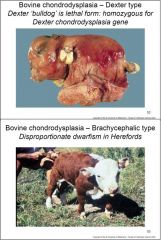
|
|
|
|
Examples of chondrodysplasia in sheep
|
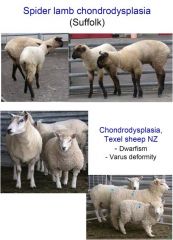
Note: spider lamb exception with long limbs
|
|
|
|
Examples of chondrodysplasia in dogs
|
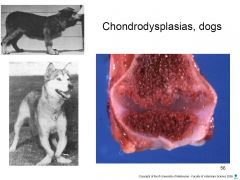
Inherited defect in Alaskan Malamutes, English pointer, Scottish Deerhound & others
|
|
|
|
Why do the tongues stick out in chrondrodysplastic animals?
|
Soft tissue growth is not affected
|
|
|
|
Features of long bones in most chondrodysplasias
|

Epiphyses are enlarged and mushroom shaped dt
arrested interstitial growth along with normal appositional growth |
|
|
|
Varus
Valgus |
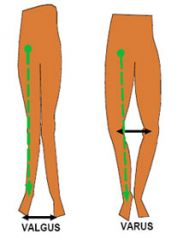
Valgus is knock-kneed
|
|
|
|
Osteodysplasia
|
Abnormal development of bone
|
|
|
|
Osteogenesis imperfecta
- cause - pathogenesis |
Inherited defect in Type I collagen
Autosomal dominant in some breeds Abnormal bone shape Susceptibility to fractures |
|
|
|
Osteogenesis imperfecta
Cattle breed most affected |
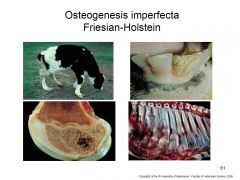
|
|
|
|
Osteopetrosis
- cause - pathogenesis |
Defective osteoclast function
Poor remodelling, increased fragility mostly a LETHAL trait |
|
|
|
Osteopetrosis
- unusual features of long bones |
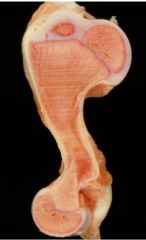
Osteoclast defect - Medullary cavity filled with coarsely woven bone and cartilage - Thin diaphyseal cortices
|
|
|
|
Congenital hyperostosis
- affects - pathogenesis |
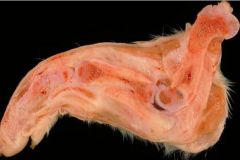
Inherited disorder in Landrace pigs
Thick limbs dt subperiosteal fibrosis and new bone deposition possibly due to vascular drainage anomaly |
|
|
|
Exostosis
|
Benign new growth projecting from bone surface and characteristically capped by cartilage
|
|
|
|
Osteochondromatosis
|
Inherited condition in humans, dogs & horses
Single or multiple tumour-like exostoses |
|
|
|
3 main generalised dysplasia
- brief cause |
Chondrodysplasia: defect in cartilage formation
Osteogenesis imperfecta: defect in Type I collagen Osteopetrosis: defect in osteoclast function |
|
|
|
Localised skeletal dysplasia
- 4 main sites |
Limbs
Skull Vertebrae Cervical vertebrae |
|
|
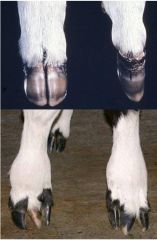
What's this?
|

Syndactylyl
Polydactyly |
|
|

What's this?
What's the opposite called? |
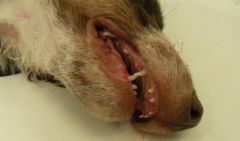
Brachygnathia inferior
opp = brachygnathia superior |
|
|
|
Scoliosis
Kyphosis |
Scoliosis: lateral deviation of the spine
Kyphosis: dorsal deviation of the spine (humpbacked) |
|
|
|
Spina bifida
- most common in which animal |
Defective closure of dorsal vertebral laminae in a segment of the vertebral column (dt defective neural tube closure)
Manx cats (lethal) |
|
|
|
"Wobbler syndrome"
- correct name |
Cervical vertebral stenotic myelopathy
|
Cevical vertebral s____ m_____
|
|
|
"Wobbler syndrome"
- animals most affected |
Horses & large breed dogs (esp Great Danes, Dobermans)
|
|
|
|
"Wobbler syndrome"
- 2 forms |
Cervical vertebral instability
- cord damage is due to abnormal movement of neighbouring vertebra Cervical static stenosis - static lesion, present in all neck postures |
|
|
|
"Wobbler syndrome"
- pathogenesis in horses |
Cervical instability most common
- high energy diets fed to genetically predisposed yearlings - C3 - C5 often - progressive hind limb ataxia dt compression or stretching of cord |
|
|

Transection of cervical spinal cord from horse
|
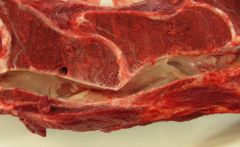
Wobbler Syndrome
Cervical vertebral stenotic myelopathy "cervical vertebral instability" form |
|
|
|
2 genetic diseases INdirectly affecting the skeleton
|
Lysosomal storage diseases
- mucopolysaccharidoses - GMI gangliosidosis Congenital erythropoietic porphyria |
|
|
|
Genetic diseases INdirectly affecting the skeleton
- Systems most affected |
CNS principally affected
Also skeletal deformities |
|
|
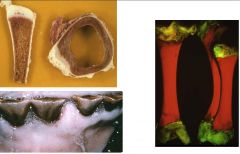
Samples from cattle
What condition is this showing? |

Congenital erythropoietic porphyria
|
|
|
|
Congenital erythropoietic porphyria
- pathogenesis in cattle |
Inherited enzyme deficiency leading to accumulation of porphyrins in blood, bone, other tissues
Red brown discolouration of teeth and bones Teeth & bones -> cherry red with UV exposure Mild-mod anaemia Photosensitisation if deposited in skin |
|
|
|
What are "acorn calves"?
What is the likely cause? |
Acorn calves have skeletal abnormalities
- disporportionate dwarfism, joint laxity - sometimes vargus, valgus - sometimes brachygnathia superior Possible dt in utero exposure to a MYCOTOXIN (acorns are blameless!) |
|
|

What's this?
|
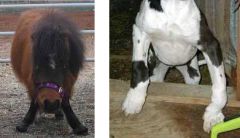
Valgus (knock knees) Varus (bow legs)
|
|
|
|
Viruses affecting bone cell activity
|
BVDV (a pestivirus)
Classical swine fever (a pestivirus) Canine distemper virus FeHV - possible dt viral destruction of osteoclasts (same cell lineage as monocytes/macrophages) |
|
|
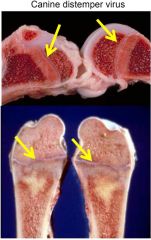
What's the arrow pointing to?
|

"Growth arrest lattices"
dt impaired remodelling due to reduced osteoclast activity |
|
|
|
What's the difference between "growth arrest lattices" and "growth arrest lines"
|
Growth arrest lattices are primary trabeculae that do not remodel dt paucity of osteoclasts - may resolve once antigen removed (eg canine distemper)
Growth arrest lines are due to reduced bone growth often dt malnutrition or starvation. It is a horizontal plate of bone, signaling interrupted growth. |
|
|
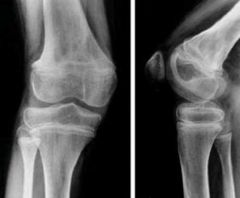
What's this showing?
|

Malnutrition or starvation retard longitudinal bone growth, thin the physis and form a bony plate in the metaphysis.
Resumption of growth following correction forms a growth arrest line (radiotranslucent) |
|
|
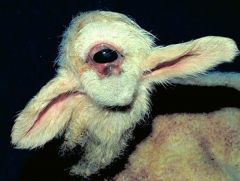
What's this?
What's it due to? |

Cyclops lamb
Plant Verratrum californicum toxicity - effects depend on stage of pregnancy exposed |
|
|
|
Inflammatory conditions of bone (3)
|
Periostitis
Osteitis Osteomyelitis |
|
|
|
Periostitis
|
Inflammation of bone with the periosteum involved
|
|
|
|
Osteitis
|
General term for inflammation of bone, rarely used.
|
|
|
|
Osteomyelitis
|
Inflammation of bone with the medullary cavity involved
|
|
|
|
Non-infectious inflammation of bone
- how? |
Single episode or repeated trauma
thus periostitis bc periosteum is involved |
|
|
|
Possible routes of infection of bone (3)`
|
Haematogenous (embolic during septicaemia)
Direct implantation (penetrating trauma) Local extension (from infected adjacent structure) |
|
|
|
Why are growth plates vulnerable to haematogenous infection?
|
Fenestrated capillary loops (bendy bits slow down) in the metaphysis
|
|
|
|
4 steps in bone lesions dt bacterial infection (in detail)
|
1. Exudate + oedema > incr intramedullary pressure > ischaemia
2. Vascular stasis, infarction, toxic products (leukocytes, dying cells, bacterial toxins) > bone necrosis 3. Phagocytosis & osteoclastic resorption of necrotic bone, and/or 4. Necrotic bone remains as a sequestrum |
|
|
|
Sequestrum & Involucrum
|
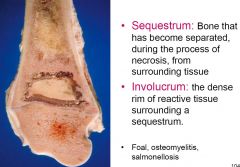
|
|
|
|
3 sequelae to osteomyelitis
(not including resolution) |
Pathologic fractures
Growth disturbances, esp if physes involved Damage to articular cartilage & extension into joints |
|
|
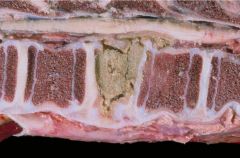
Calf vertebral column.
What's this? Likely cause? |
Vertebral ostemomyelitis and necrosis
Actinomyces pyogenes |
|
|
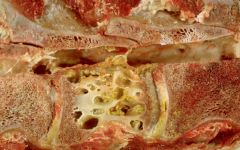
Bovine vertebrae. Causative agent?
|

Hydatid cyst
|
|
|

Bovine mandible
Common name Correct name Causative agent |

Lumpy jaw
Chronic pyogranulomatous osteomyelitis Actinomyces bovis |
|
|
|
Common infectious agents causing osteomyelitis
|
Viruses: BVDV, classical swine fever, canine distemper
Bacteria: cattle: Actinomyces pyogenes, Actinomyces bovis horses: Rhodococcus equi Fungi: Aspergillus (dogs) Protozoa: Leishmania (dogs) |
|

